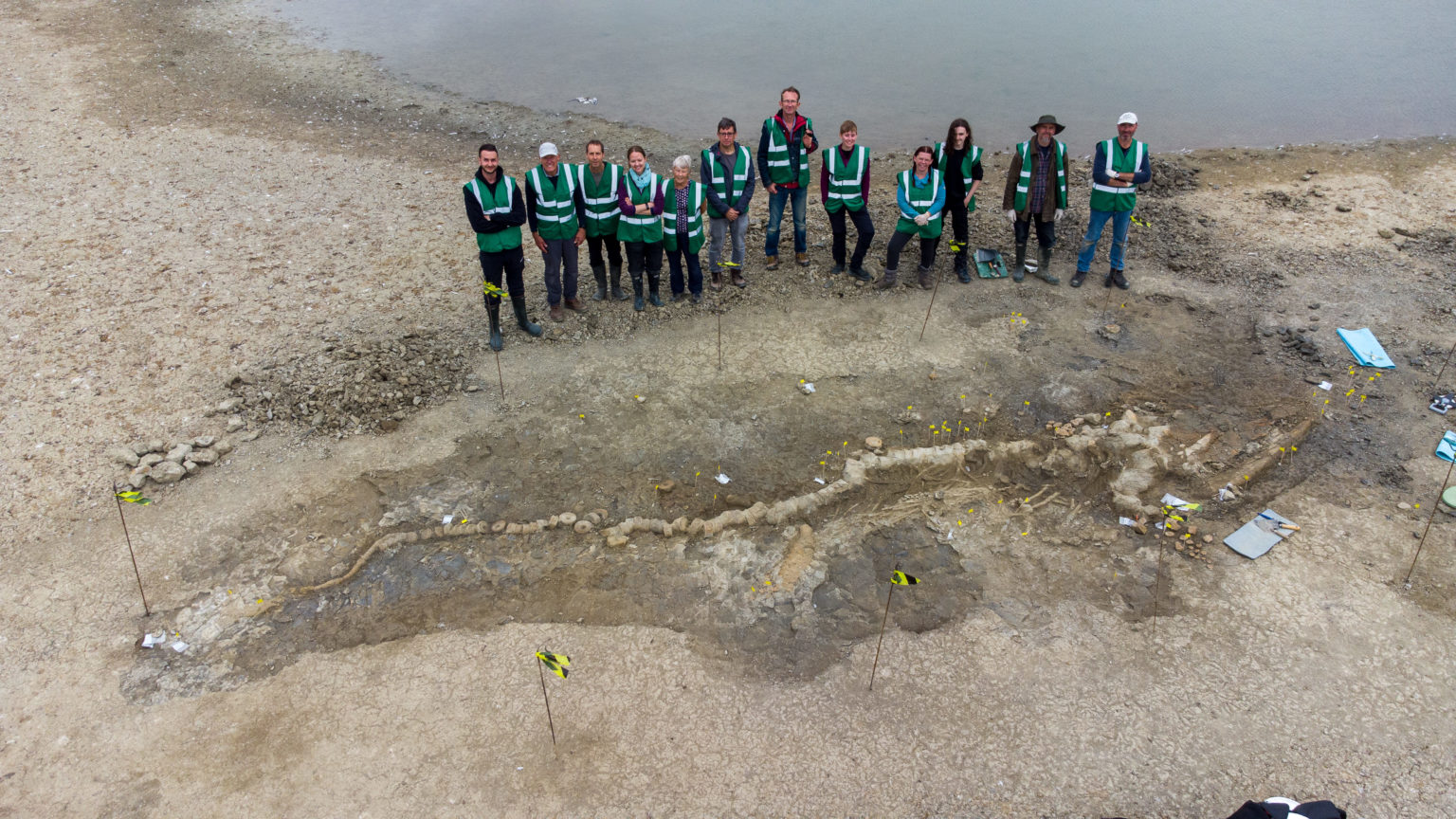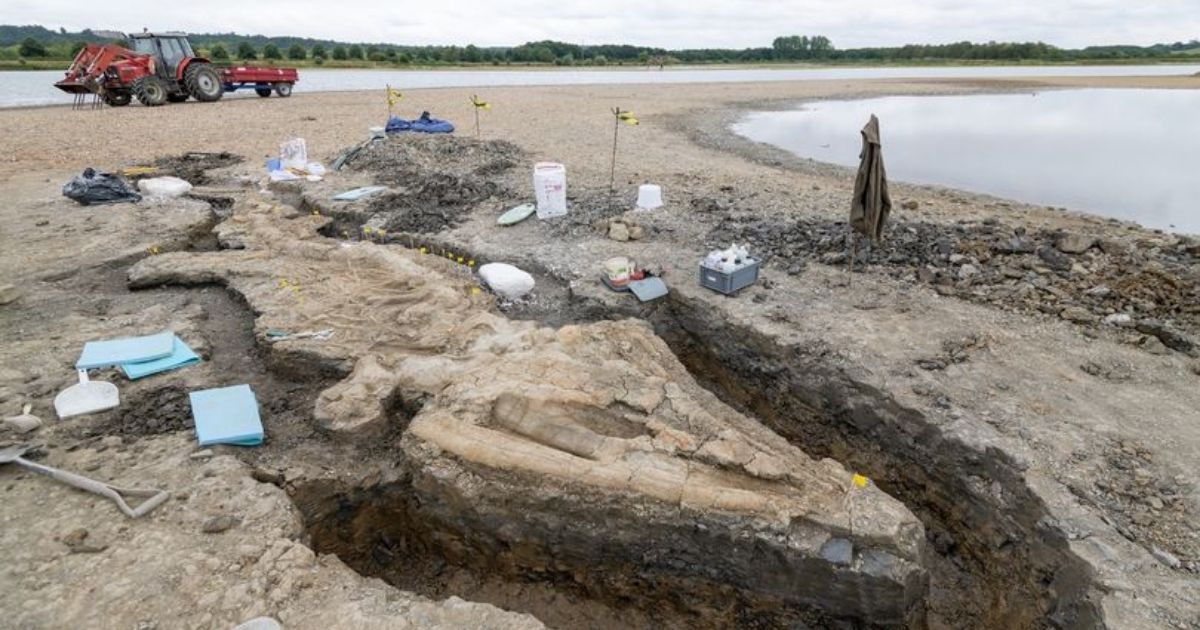The fossilized remains of Britain’s largest ichthyosaur, known as a ‘Sea Dragon’, has been discovered at the Rutland Water Nature Reserve, in the East Midlands. It is the biggest and most complete skeleton of its kind found to date in the UK and is also thought to be the first ichthyosaur of its species (called Temnodontosaurus trigonodon) found in the country.
The remains were fully excavated earlier this year and featured on BBC Two’s Digging for Britain, on Tuesday 11 January at 20.00 UK time, before being made available on BBC iPlayer.
The ichthyosaur was discovered by Joe Davis, Conservation Team Leader at Leicestershire and Rutland Wildlife Trust, who operates the nature reserve in partnership with Anglian Water, during the routine draining of a lagoon island for re-landscaping at Rutland Water in February 2021.
Joe Davis said: “The find has been absolutely fascinating and a real career highlight, it’s great to learn so much from the discovery and to think that this amazing creature was once swimming in seas above us, and now once again Rutland Water is a haven for wetland wildlife albeit on a smaller scale!”
 Palaeontologists working on the Ichthyosaur skeleton found at Rutland Water. Credit: Anglian Water.
Palaeontologists working on the Ichthyosaur skeleton found at Rutland Water. Credit: Anglian Water.
The ichthyosaur is approximately 180 million years old and, with a skeleton measuring around 10 meters in length and a skull weighing approximately one ton, it is the most complete large ichthyosaur ever found in Britain.
Ichthyosaurs first appeared around 250 million years ago and went extinct 90 million years ago. They were an extraordinary group of marine reptiles that varied in size from 1 to more than 25 meters in length, and resembled dolphins in general body shape.
The fragile remains of the huge skeleton were carefully excavated in August and September 2021 by a team of expert paleontologists assembled from around the UK, in partnership with Anglian Water, Rutland County Council and the Leicestershire and Rutland Wildlife Trust. The excavation was led by world ichthyosaur expert Dr Dean Lomax and specialist paleontological conservator Nigel Larkin, along with marine reptile specialist Dr Mark Evans from British Antarctic Survey (BAS), Dr Emma Nicholls from the Horniman Museum and volunteers with experience of excavating fossilized marine reptiles.
Paleontologist Dr Mark Evans of British Antarctic Survey and a Visiting Fellow at the University of Leicester said:
“I’ve been studying the Jurassic fossil reptiles of Rutland and Leicestershire for over twenty years. When I first saw the initial exposure of the specimen with Joe Davis, I could tell that it was the largest ichthyosaur known from either county. However, it was only after our exploratory dig that we realized that it was practically complete to the tip of the tail. Rutland’s motto, “Multum in Parvo”, translates as “Much in Little” so it is fitting that we’ve found Britain’s largest ichthyosaur skeleton in England’s smallest county. It’s a highly significant discovery both nationally and internationally but also of huge importance to the people of Rutland and the surrounding area.”
The discovery is not the first at the Anglian Water reservoir, with two incomplete and much smaller ichthyosaurs found during the initial construction of Rutland Water in the 1970s. It is however the first complete skeleton to be discovered there.
Dr Dean Lomax, a paleontologist and a Visiting Scientist affiliated with the University of Manchester, who has studied thousands of ichthyosaurs and named five new species in the process, said: “It was an honor to lead the excavation. Britain is the birthplace of ichthyosaurs – their fossils have been unearthed here for over 200 years, with the first scientific dating back to Mary Anning and her discoveries along the Jurassic Coast. Despite the many ichthyosaur fossils found in Britain, it is remarkable to think that the Rutland ichthyosaur is the largest skeleton ever found in the UK. It is a truly unprecedented discovery and one of the greatest finds in British paleontological history.”
Nigel Larkin, specialist paleontological conservator and Visiting Research Fellow at Reading University, said: “The block containing the massive 2m-long skull weighs just under a ton (comprising the fossil, the Jurassic clay in which it lies, and the encasing plaster of paris and wooden splints). The block containing the body section weighs about a ton and a half. It’s not often you are responsible for safely lifting a very important but very fragile fossil weighing that much. It is a responsibility, but I love a challenge. It was a very complex operation to uncover, record, and collect this important specimen safely.”
The team of paleontologists will continue to work on the research and conservation of this significant scientific discovery, with academic papers to be published in the future.



